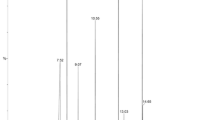Abstract
To study the mechanism of action of water soluble compound GII purified from fenugreek (Trigonella foenum graecum) seeds which was shown earlier to have antidiabetic effect in the subdiabetic, moderately and severely diabetic rabbits. In rabbits (1–1.5 kg bw) diabetes was induced by intravenous injection of 80 mg/kg bw of alloxan. They were fed with GII at a dose of 50 mg/kg bw daily once in the morning for 15 days in the subdiabetic and moderately diabetic and 30 days in the severely diabetic rabbits. Serum total cholesterol (TC), triglycerides (TG), LDL + VLDL cholesterol [(LDL + VLDL)C], HDL cholesterol [(HDL)C], total tissue lipids, glycogen and enzymes of carbohydrate metabolism (glycolysis, gluconeogenesis, polyol pathway) hexokinase, glucokinase, pyruvate kinase, malic enzyme, glucose-6-phosphatase, glucose-6-phosphate dehydrogenase, aldose reductase and sorbitol dehydrogenase and antioxidant enzymes glutathione peroxidase, glutathione reductase and superoxide dismutase were estimated. Liver and kidney function parameters were also estimated. Treatment with GII for 15 days in the subdiabetic and moderately diabetic rabbits and for 30 days in the severely diabetic rabbits (i) decreased the elevated lipids TC, TG, (LDL + VLDL)C and increased the decreased (HDL)C, (ii) decreased the elevated liver and heart total lipids, TC and TG, (iii) increased the decreased liver and muscle glycogen, (iv) increased the decreased hexokinase, glucokinase, pyruvate kinase, malic enzyme, glucose-6-phosphate dehydrogenase, superoxide dismutase, glutathione peroxidase, (v) decreased the increased glucose-6-phosphatase, sorbitol dehydrogenase, aldose reductase. Results thus show that treatment with GII compound purified from fenugreek seeds for 15 days in the subdiabetic and moderately diabetic and 30 days in the severely diabetic rabbits corrects the altered serum lipids, tissue lipids, glycogen, enzymes of glycolysis, gluconeogenesis, glycogen metabolism, polyol pathway and antioxidant enzymes. Histopathological abnormalities (fatty infiltration and other cellular changes) seen in the pancreas, liver, heart and kidneys were repaired after treatment with GII. In fact partially damaged pancreas was repaired. Liver and kidney function test results were normal in the GII treated animals indicating that GII treatment is safe and free from any side effects.



Similar content being viewed by others
References
Moorthy R, Prabhu KM, Murthy PS. Mechanism of anti-diabetic action, efficacy and safety profile of GII purified from fenugreek (Trigonella foenum-graceum Linn) seeds in diabetic animals. Ind J Exp Biol. 2010;48:1119–1122.
Moorthy R, Prabhu KM, Murthy PS. Anti-hyperglycemic compound GII from fenugreek (Trigonella foenum-graceum Linn) seeds, its purification and effect in diabetes mellitus. Ind J Exp Biol. 2010;48:1111–1118.
Puri D, Prabhu KM, Murthy PS. Effect of GII compound purified from fenugreek (Trigonella foenum-graceum Linn) seeds in diabetic rabbits. Ind J Clin Biochem. 2011 (in press).
Folch J, Lees M, Stanley GHS. A simple method for the isolation and purification of total lipids from animal tissues. J Biol Chem. 1957;226:497–509.
Carrol NV, Longley RW, Roes JH. The determination of glycogen in liver and muscle by use of anthrone reagent. J Biol Chem 1956;200:583–93.
Gumma KA, McLean P. The kinetic quantitation of ATP-glucose-6-phosphotransferase. Federation of European Biological Society (FEBS) Letters. 1972;27:293–7.
Gutman I, Bernt E. Pyruvate kinase: assay in serum and erythrocytes. In: Bergmeyer HU, editor. Methods in enzymatic analysis. New York: Academic Press; 1974. p. 774–8.
Harper AE. In: Bergmeyer HU, editor. Methods in enzymatic analysis. New York: Academic Press; 1965.
Fiske CH, Subbarow Y. The colorimetric determination of phosphorous. J Biol Chem. 1925;66:375–400.
World Health Organizatio Technical Report Series. Standardization of procedure for study of glucose-6-phosphate dehydrogenase Series No. 366; 1967.
Pottinger PK. A study of three enzymes acting on glucose in lens of different species. Biochem J. 1967;104:663–8.
Marklund SL, Marklund SL. Involvement of the superoxide and ion radical in the autoxidation of pyrogallol and a convenient assay for superoxide dismutase. Eur J Biochem. 1974;47:469–74.
Author information
Authors and Affiliations
Corresponding author
Rights and permissions
About this article
Cite this article
Puri, D., Prabhu, K.M., Dev, G. et al. Mechanism of Antidiabetic Action of Compound GII Purified from Fenugreek (Trigonella foenum graecum) Seeds. Ind J Clin Biochem 26, 335–346 (2011). https://doi.org/10.1007/s12291-011-0150-2
Received:
Accepted:
Published:
Issue Date:
DOI: https://doi.org/10.1007/s12291-011-0150-2




